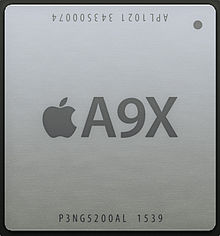Apple A9X

Apple A9X chip
|
|
| Produced | From September 9, 2015 to Present |
|---|---|
| Designed by | Apple Inc. |
| Common manufacturer(s) | |
| Max. CPU clock rate | 2.16 GHz to 2.26 GHz |
| Min. feature size | 16 nm (TSMC) |
| Instruction set | A64, A32, T32 |
| Microarchitecture | TwisterARMv8-A-compatible |
| Product code | APL1021 |
| Cores | 2 |
| L1 cache | Per core: 64 KB instruction + 64 KB data |
| L2 cache | 3 MB shared |
| Predecessor | Apple A8X |
| Successor | Apple A10 Fusion |
| GPU | PowerVR Series 7XT (12 cores) |
| Application | Mobile |
| Variant | Apple A9 |
The Apple A9X is a 64-bit ARM based system on a chip (SoC) designed by Apple Inc. It first appeared in the iPad Pro, which was announced on September 9, 2015 and was released on November 11, 2015. The A9X has the M9 motion coprocessor embedded in it, a new innovation not seen in previous chip generations. It is a variant of the A9 and Apple claims that it has 1.8 times the CPU performance and 2 times the GPU performance of its predecessor, the A8X.
The A9X features an Apple-designed 64-bit ARMv8-A dual-core CPU called "Twister". It offers double the memory bandwidth and double the storage performance of the Apple A8X.
Unlike the A9, the A9X does not contain a L3 cache due to its significant DRAM bandwidth. The A9X is paired with 4 GB of LPDDR4 memory in the 12.9" iPad Pro and 2 GB of LPDDR4 memory in the 9.7" iPad Pro with a total bandwidth of 51.2 GB/s. This high bandwidth is necessary to feed the SoC's dodeca-core PowerVR 7 Series GPU cores. The RAM is not included in the A9X package unlike its sibling, the A9.
The A9X uses the same NAND interface as the A9, which uses an Apple-designed NVMe-based controller that communicates over a PCIe connection. The iPad Pro's NAND design is more akin to a PC-class SSD than embedded flash memory common on mobile devices. This gives the iPad Pro a significant storage performance advantage over competitors which often use mSATA or eMMC to connect to their storage systems.
...
Wikipedia
